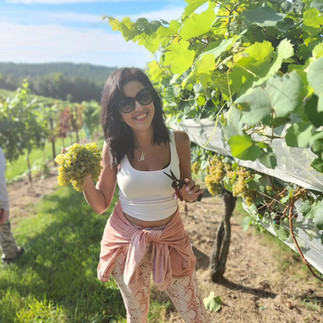Deciphering the Perfect Moment: How Vintners Determine Grape Harvest Time
- Sep 7, 2023
- 3 min read
The art of winemaking is an intricate dance that spans months, if not years. Yet, one of the most pivotal decisions in this process is determining when to harvest the grapes. This singular choice can significantly influence a wine's flavor, structure, and aging potential. But how do vintners decide on that perfect moment? Let's delve into the complexities that dictate this decision.
The Essence of Timing
In the world of viticulture, timing isn't just crucial—it's everything. Harvest too early, and the grapes might lack the requisite sugars or have too much acidity, leading to a wine that's sharp and underwhelming. Harvest too late, and the risk of overripeness looms, which could result in a wine that's overly alcoholic or lacking balance.
The Holy Trinity: Sugar, Acid, and Tannins
The core decision on when to harvest revolves around the balance of three primary components:
Sugars: As grapes ripen, they accumulate sugars. Sugar levels, often measured in Brix in the U.S., play a crucial role in determining the potential alcohol level of the wine. Yeast consumes this sugar during fermentation, converting it to alcohol.
Acidity: Grapes contain two main acids – tartaric and malic. As they ripen, the acid levels drop. Wines need a certain acidity level to ensure they're fresh and well-structured.
Tannins: Predominantly a concern for red wines, tannins are compounds found in grape skins and seeds. Over time, tannins mellow and become less astringent. Vintners taste and feel the tannins by chewing the grape seeds. If they're still very astringent, it might be too early to harvest.
The Nuances of Grape Variety and Wine Style
Different grape varieties mature at various rates. Early-ripening varieties like Pinot Noir or Chardonnay might be harvested weeks before late-ripening varieties like Cabernet Sauvignon or Mourvedre. The intended style of wine also plays a role. For instance, grapes destined for sparkling wine are typically harvested earlier, when acid levels are higher.
Mother Nature's Whims
Weather significantly influences the decision-making process. If rain is forecasted, vintners might decide to harvest earlier to prevent potential dilution, rot, or fungal diseases. Conversely, a few extra days of sunshine might provide just the boost needed for grapes to reach optimal maturity.
Experience and Intuition
While science and data are invaluable, the seasoned intuition of a vintner is irreplaceable. Experienced winegrowers can often tell the ripeness level by merely looking at the grape clusters or tasting them.
Technological Assistance
Today, many winemakers use technology to aid their decision-making. Drones equipped with multispectral cameras can provide data about vineyard health and grape ripeness. Lab equipment can analyze sugar and acid levels with precision, helping to paint a clearer picture of grape maturity.
Regional Traditions
In some wine regions, tradition dictates the harvest. For instance, in Germany's Mosel region, Eiswein (Ice Wine) producers wait for the first deep freeze before harvesting, ensuring the grapes are frozen on the vine.
Global Challenges and Changing Climate
Climate change poses significant challenges for vintners. Rising temperatures have led to earlier ripening in many regions, which can disrupt established viticultural practices and timelines. Vintners must now adapt, sometimes seeking cooler sub-regions or changing their vineyard practices to ensure grapes don't ripen too quickly.
Determining the optimal time to harvest grapes is a complex decision that blends science, intuition, and experience. It's a decision that can define the vintage and the wine itself. So, the next time you enjoy a glass of wine, take a moment to reflect on the intricacies and dedication that went into choosing that perfect harvest moment. The world of wine is deep and multifaceted, and the journey from vine to glass is one of careful deliberation and passi
on. Cheers to Harvest and thank you to all vitners, harvest workers, and volunteers making this labor of love possible so we can enjoy always some good vino!
















Comments